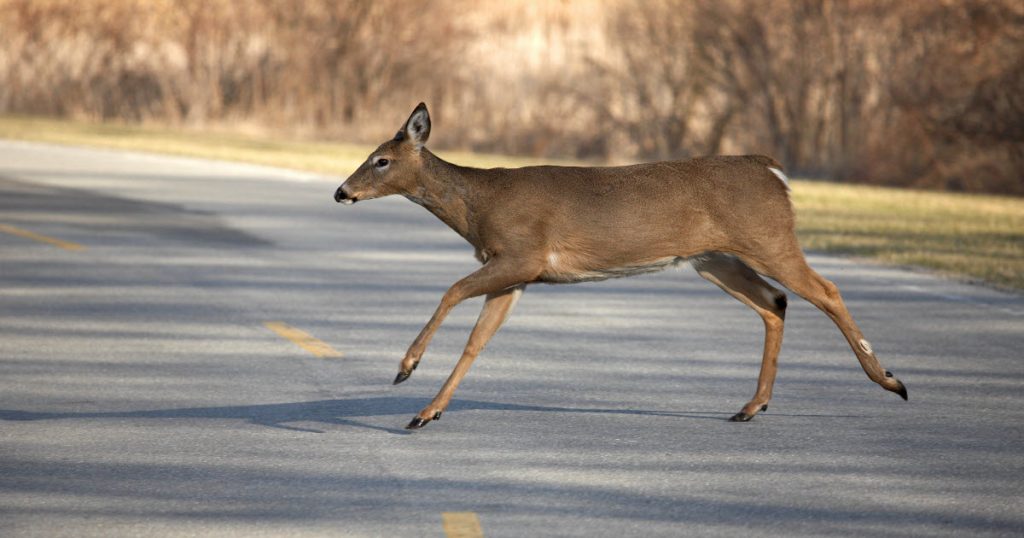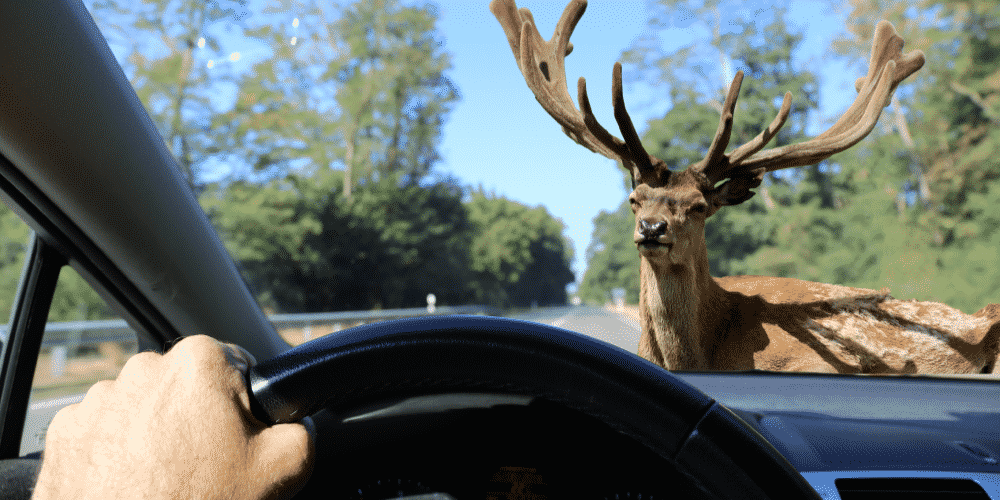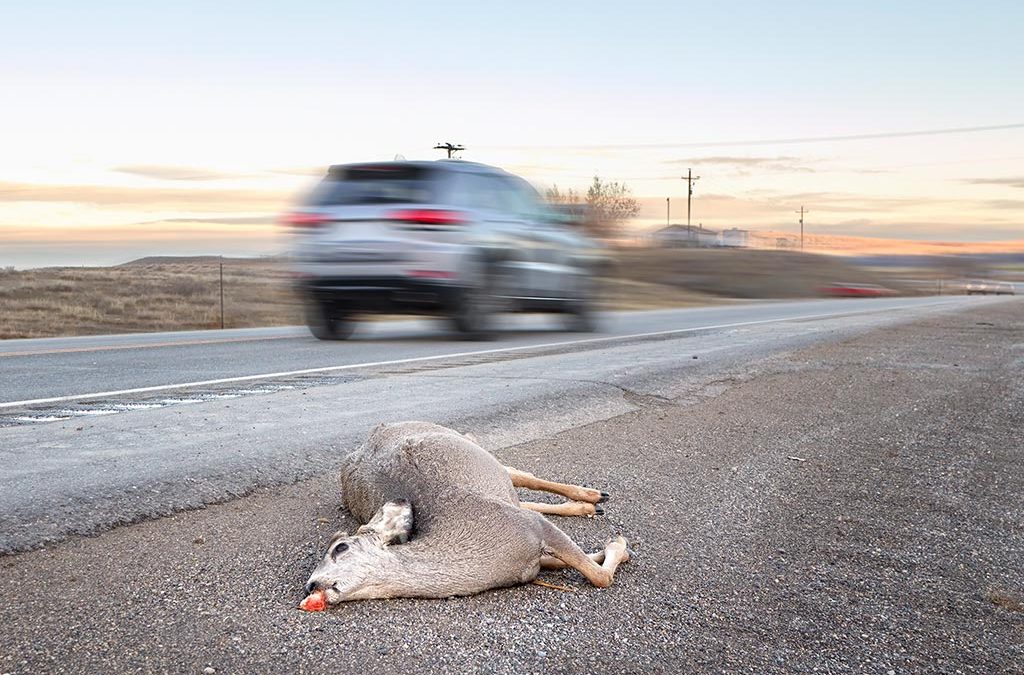Deer vehicle accidents may be exceedingly harmful, and not only for the animal. Drivers are always searching for novel solutions to safeguard themselves from animal mishaps and deer accidents.
Why do deer jump in front of cars? A few possibilities for deer-vehicle collisions include using loud headlights and deer whistles that can be attached to the front of a car and produce noise. Still, those don’t function effectively and typically don’t do anything to avoid a hazard.
If you’re lucky, you slam on the brakes or swerve out of the road just in time to send the deer running for the nearest cover.
Where Do Deer Live?
Deer travel about to hunt food, but they also possess safer locations where they like to lie down or sleep. They like to stay deep in the forest, where they may hide among leaves and heavy vegetation in the summer and early fall.
When the leaves on trees begin to die and fall, they become more vulnerable to harm and are more inclined to wander about. They also search for fresh food. During the rutting season, both men and females are on the move.
Why Do Deer Jump in Front of Cars? – 4 Main Reasons
Deer-vehicle collisions are very common these days. However, there are no definitive reasons why deer get hit by cars or leap onto the road in front of any vehicle. As a result, they are not doing it on purpose.
It’s not like deer are normally drawn to autos or anything. However, some certain rational ideas and actions may be linked to this deer’s behaviour.

1. Casual Crossing
Often, deer cross the road since they have to go to anything on the other side. If they run out of food in their present location, for example, they’ll have to explore different areas, some of which may require crossing the road.
Dear spend the bulk of their time far from their young to limit the possibility of predators discovering their hiding site, but she has to come back a number of times every 24-hour cycle to provide them milk.
Not only will a collision kill the deer, but it will also kill her young.
2. Headlights
Accidents involving deer are often caused by headlights, particularly at night. When they gaze at the high beam, they get briefly blinded, causing them to stand still or to rush in an erroneous direction.
When new roads are constructed in established deer ecosystems, the deer may continue along their customary routes and lengths without realizing they are in danger. The primary reason why deer jump in front of your car is fear.
3. Easily Terrified
Deer are easy to spook out, who will flee at the splitting of a twig, so the noise of your Toyota Corolla chewing up the asphalt may throw them into a frenzy.
As a result, if you see deer while driving downward, the animal will most likely escape upward. The animal would also see the car as a hill and hence choose to jump over it.
Given this, a deer may just run into the road, paying little heed to direction, and it’s not unusual for them to wind up on the road, especially if it’s a new construction and the animal fails to comprehend the commotion.
4. New Highways
Year after year, several new roadways are constructed to improve the nation’s infrastructure and communication between dispersed areas; most of these highways wind through relatively undeveloped areas, where most deer are populated.
Since roads may be wholly unfamiliar concepts to deer in these areas, it’s likely that they won’t be aware of the risk they bring and will thus likely cross them carelessly.
How to Avoid Hitting A Deer?

1. Gain More Fields of Vision
Remember to switch on your bright lights when traveling at night in a suburban or rural area. This is advantageous since it will enhance the likelihood that you will see any deer at the side of the road.
Just be mindful that your high beams may briefly dazzle other drivers, particularly those in oncoming traffic.
Be aware that your intense rays by which deer tend to go blind. As a result, you must drive carefully and cautiously. Remember that blind deer that are disoriented are far more unpredictable.
Just because a deer seems to have spun around or gone away from the road doesn’t mean it won’t immediately come back.
2. Brakes
If a collision with a deer appears inevitable, hit the brakes forcefully while maintaining control of the car. Do not swerve. Swerving might make it more likely to lose control or hit anything else. The faster you stop your car, the better your chances of avoiding a collision.
3. Honk Your Horn
Some authorities advise giving the horn a single, prolonged blast to keep deer off the road. Many drivers fail to realize that deer often are another target for their horns, in addition to erratic motorists.
A loud blast from your automobile horn may be sufficient to scare away a deer if it darts in front of your moving vehicle. One of your few opportunities to avert an accident is to honk.
4. Watch Out for Deer Groups
Bear in mind that deer frequently migrate in groups. If a single deer crosses the road, go more slowly and keep an eye out for more since there might be another deer along it. Fawns follow their mother deer in the spring and summer, while females move together in the winter.
Could a Deer Collision Destroy Your Car?
As we’ve seen, deer crashes pose a serious risk to both the animal and the people inside the car.
Front-end Damage
A deer might dart in front of the car, which can cause damage to the front of the car, which might harm the grille, bumper, headlights, hood, and other parts. The engine or other important components may occasionally sustain damage if the collision is strong enough.
Windshield Damage
If a deer runs into a car, it may crack or shatter the windshield, impairing sight and perhaps necessitating a new windshield.
Body Damage
A deer accident may cause the vehicle’s body to sustain dents, scratches, and other aesthetic harm. Depending on the vehicle’s speed and the location of the collision, the degree of damage might change.
Adult white-tailed deer are large animals, which causes them to do greater harm when they collide. The maximum weight of a male deer is 300 pounds.
What Steps Should You Take If You Hit a Deer?

1. Relocate Your Vehicle to a Safe Spot
After you strike a deer, relocate your car to a safe area off the side of the road. Make sure you’re out of the way of oncoming traffic from both directions, and turn on your warning lights to make yourself visible to other drivers.
2. Keep a record of the event
Take pictures of the situation, including the surroundings, your car’s damage, and any other important information. These records might be useful for insurance considerations.
3. Analyze the circumstance
Verify your own health and the health of any passengers. Contact emergency services right away if someone is hurt or needs medical care.
4. Do not approach the dead
Maintain a safe distance from it. When confronted, injured animals may be unpredictable and dangerous. A scared or hurt deer may also pose a threat to both you and yourself.
5. Check for signs of vehicle damage
After the occurrence, keep an eye out for any symptoms of damage to your car that might compromise its ability to operate safely. Pay close attention to the steering, brakes, and other important parts.
6. Inform the insurance company
As soon as you can, get in touch with your insurance provider to report the occurrence. They will give you guidance on what data they need and walk you through the claims procedure.
Conclusion
Accidents involving deer and vehicles are common, especially while driving on roads close to deer’s natural habitat. Driving should be done with caution on such roads.
Vehicles and deer collide frequently. Driving needs to be done with great caution in areas where deer are frequent. Your eyes should be alert to any approaching danger that might get you into difficulty if not seen.
FAQs
How do I keep deer from jumping in front of my car?
Whenever feasible, turn your headlights all the way up. When driving at night or in the early morning, you can obtain a wider perspective of the road and the surroundings.
Why do deer run away from humans?
Deer are known to be cautious animals that run away quickly upon approaching humans. Deer, though, may become quite combative while defending their young.
What scares deer away while driving?
Give your car’s horn one long blast when you see a deer in front of you to scare any deer away from the road.



